We rolled into the Phoenix area a few days ago, Monday, I think. Phoenix is a very big city, and the surrounding metroplex has something like 4.5 million people, the 6th largest in the country. And major league baseball Spring Training is in full swing.
(Full swing, get it?)
But I get ahead of myself.
On our way up from Tucson, we passed by a unique hill called Picacho Peak. There is also a state park of that name, so I had to find out why.
 |
| Picacho Peak, Civil War battle site |
"The Battle of Picacho Pass" was an engagement of the American Civil War on April 15, 1862...and marks the westernmost battle of the Civil War".
Did you all know that Arizona fought on the side of the Confederacy, and California was Union? This battle was to keep the Confederates from crossing over the border into Arizona.
Arizona was the last state in the contiguous U.S. to achieve statehood, not joining the union until 1912. Up until that point, it was part of New Mexico, well, after it separated from Mexico proper. So there's your history lesson for today.
We stayed in a massive RV park, euphemistically named "Desert Shadows". It was sprinkled with delightfully fragrant orange and grapefruit trees, and offered all sorts of crafts, shuffleboard and jigsaw puzzles. We were the youngest people there by at least 15 years... which, in Jack's case, is really saying something.
Our first excitement in Phoenix was to see our old favorite, Rubio's Tacos. We IMMEDIATELY headed there for their great tacos.
 |
| Que Bueno!!! |
I (Stacy) had coffee with a woman I worked with in Sacramento. She is now the NICU educator at Banner Hospital, but was able to break away for a coffee.
Jack and I met my cousin, Kathy, and her husband, Dan, for a great dinner and some family catch up time.
 |
| Cousin Kathy, Stacy, Jack and Dan at True Foods Kitchen. |
Then we met up our old buddy from our FIRST time in Portland back in the '80s, Mike McAvoy. Mike now lives in Sun City with his beautiful English Setter, Sam. We attended a baseball game (Milwaukie Brewers 9, Seattle Mariners 7), had fantastic gyros, and visited for a few hours with Mike at his lovely home.
 |
| We even sang "Take Me Out to the Ballgame" at the 7th inning stretch |
We drove north today towards Flagstaff, stopping at an old Native American village called "Montezuma's Castle" It is a well-preserved cliff structure, that was built about 1,400 years ago, and occupied up until about 500 years ago. Very interesting indeed.
 |
| Cliff dwelling at Montezuma's Castle. |
 |
| The inhabitants reached their homes by a series of ladders |
This is truly desert: lots of cactus and spiny, scary trees. Everything has decided it's Spring, so flowers and pollen abound.
 |
| Along Verde Creek |
 |
| Overlooking Horsethief Canyon |
And it is evidently important to watch your step...
Tomorrow.....The Grand Canyon!
























































